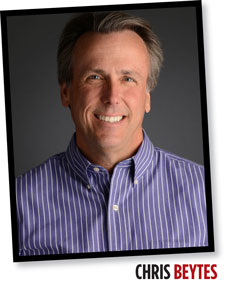2/1/2023
Shrinkflation (and Its Evil Twin)
Chris Beytes

Does it tick you off when a “pint” of ice cream contains just 14 oz.? And a “pound” of coffee is really only 12 oz.? It does me. That’s called downsizing, or more popularly “shrinkflation,” and it’s a way for a manufacturer to charge the same money for less product, thereby boosting (or maintaining) profitability.
Looking at poinsettias at retail for three weekends in December put me in mind not of shrinkflation, but of our container and product sizes in general, since few other products we grow come in such a vast array of both. Pot sizes run from 2 in. (often called mini) up to 12 in., in numerous half-inch increments. Some retailers may promote quarts or gallons, although I see that less often. One grower’s 6.5 in. may be another’s 7 in., and without a tape measure who really knows? Then there’s the number of plants per pot, from one up to five. Makes for a pleasing variety of choices for the consumer!
But in the end, container size or plant count matters little to her. What she sees, and what we should be promoting, is the overall look and appeal of the complete package—its “perceived value.” Does it look like it’s worth $34.95? If so, she’ll buy it.
But back to our headline topic, which came to my mind a couple weeks ago on my ride home. “Marketplace” host Kai Ryssdal was interviewing a fellow named Edgar Dworsky, AKA “Mr. Consumer.” Edgar has spent most of his career tracking the changing sizes of consumer goods. The former Massachusetts assistant attorney general and longtime consumer advocate told Kai that even as a kid he paid attention to the size of the candy bar he was getting for his hard-earned dime.
What is shrinkflation? Good examples can be found in the cereal aisle. For instance, Post has changed their “Family Size” (23 oz.) box of cereal to “Giant Size” (still 23 oz.). And they reduced the size of the “Family Size” box to 18 oz. You probably never noticed.
General Mills has made similar changes, apparently, because a spokesperson had to address the topic, explaining, “General Mills has been working to create consistency and standardization across our cereal products, making it easier for shoppers to distinguish between sizes on shelf … This change also allows more efficient truck loading, leading to fewer trucks on the road and fewer gallons of fuel used, which is important in both reducing global emissions, as well as offsetting increased costs associated with inflation.”
Ah! We’re helping save the planet by getting fewer Cocoa Puffs per box!
It reminds me a little of when some growers changed from the standard flat size of 11 x 22 to a narrower 10-in. flat that would fit more efficiently on benches and shipping racks. But that sort of space efficiency makes sense—and I don’t believe consumers got cheated because they still got 18 or 36 or 48 plants, even if the root ball was a bit smaller.
Then Edgar told Kai about “skimpflation,” which he calls shrinkflation’s evil twin. Skimpflation is when a manufacturer reformulates a product using less of an expensive component or substitutes less-expensive ingredients—essentially “watering down” a product. Recent examples can be found in store-brand cough medicines and a name-brand mouthwash, both of which were changed to contain less active ingredient.
Skimpflation comes in other guises, too, like service. If you travel, you know about the lack of maid service in hotels. Disney got in trouble after reopening from the pandemic because they weren’t running tram service from the parking lots to the main gates. And everybody bags on the airlines’ lack of service and amenities. Blame it on staffing, but customers saw it as cheap—or worse, greed.
I bring this up only to point out that, while shrinkflation and skimpflation are now commonplace in the marketplace, we don’t have to participate. In fact, we can promote ourselves as the antidote to shrinkflation. Think about it—you buy a six-pack of bedding plants, whether a jumbo six or something smaller, and in the end it can make a big, beautiful, oxygen-giving display of flowers in a bed, pot or basket. That quart perennial? Years of pleasure for you and the pollinators. Cut flowers? They may only last a week, but the joy they bring to the surprised and delighted recipient can last long after the stems have wilted.
Remember, we aren’t selling pots or a measured quantity of a product. We’re selling beauty, health, happiness, love, gratitude, joy, tranquility, shade, habitat … the myriad benefits of plants.
There’s no shrinking or skimping on that. GT